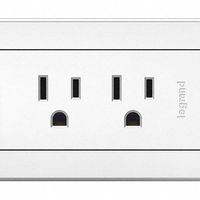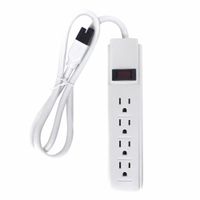Call +(254) 703 030 000 / 751 483 999 / 721 704 777
- Home
- Electrical
- Extension Cords Power Strips Cord Reels
- Power Strips Surge Protectors
.....Read More
Frequently Asked Questions
What is the difference between a power strip and a surge protector?
A power strip and a surge protector may look similar, but they serve different purposes. A power strip is essentially an extension block that allows multiple devices to be plugged into a single wall outlet. It provides additional outlets but does not offer any protection against electrical surges. Power strips are useful for expanding the number of available outlets in a given area, making it easier to power multiple devices simultaneously.
On the other hand, a surge protector, while also providing multiple outlets, includes a crucial feature: it protects connected devices from voltage spikes. Electrical surges can occur due to lightning strikes, power outages, or fluctuations in the power grid. These surges can damage or destroy electronic devices. A surge protector works by diverting excess voltage away from the connected devices, typically using components like metal oxide varistors (MOVs) to absorb the extra energy.
The key difference lies in the protection offered. While a power strip merely provides additional outlets, a surge protector safeguards your electronics from potential damage caused by power surges. Surge protectors are rated by their joule capacity, which indicates how much energy they can absorb before failing. Higher joule ratings generally mean better protection.
In summary, if you need extra outlets and are not concerned about power surges, a power strip is sufficient. However, if you want to protect valuable electronics from potential electrical damage, a surge protector is the better choice. Always check the specifications to ensure the device meets your needs, especially in areas prone to electrical disturbances.
How do I know if my power strip has surge protection?
To determine if your power strip has surge protection, look for the following indicators:
1. **Labeling and Packaging**: Check the packaging or the power strip itself for terms like "surge protector," "surge suppression," or "surge protection." These terms indicate that the device is designed to protect against power surges.
2. **Joule Rating**: Surge protectors often have a joule rating, which measures the energy absorption capacity. Look for a number followed by "J" (e.g., 1000J). A higher joule rating generally indicates better protection.
3. **Indicator Light**: Many surge protectors have an indicator light labeled "Protected" or "Protection Working." If this light is on, it suggests that the surge protection feature is active. If it's off, the protection may be compromised.
4. **UL Certification**: Check for UL (Underwriters Laboratories) certification, specifically UL 1449, which is the standard for surge protective devices. This certification ensures the device has been tested for surge protection capabilities.
5. **Clamping Voltage**: Some surge protectors list a clamping voltage, which is the voltage level at which the device will start to conduct electricity to prevent a surge. Common clamping voltages are 330V, 400V, or 500V.
6. **Warranty**: Surge protectors often come with a connected equipment warranty, which covers damage to devices plugged into the protector in case of a surge. This is a good indicator of a genuine surge protection feature.
7. **Price and Build**: Surge protectors are generally more expensive than basic power strips. They may also be bulkier due to the additional components required for surge protection.
If none of these indicators are present, it is likely just a basic power strip without surge protection.
Can I plug a power strip into another power strip?
No, you should not plug a power strip into another power strip. This practice, known as "daisy chaining," can lead to several safety hazards, including overloading the electrical circuit, which can cause overheating and potentially lead to a fire. Power strips are designed to handle a specific load, and connecting multiple strips together can exceed this capacity. Additionally, daisy chaining can result in tripping circuit breakers or blowing fuses, as the electrical system may not be able to handle the increased demand. For safety, it's recommended to use a single power strip per outlet and ensure that the total load does not exceed the strip's or the outlet's capacity. If more outlets are needed, consider installing additional wall outlets or using a power strip with a higher capacity. Always follow the manufacturer's guidelines and local electrical codes to ensure safe usage.
How many devices can I safely plug into a power strip?
The number of devices you can safely plug into a power strip depends on several factors, including the power strip's capacity, the power requirements of the devices, and the electrical load limits of the circuit.
1. **Power Strip Rating**: Most power strips are rated for a maximum load, typically around 15 amps or 1800 watts in the U.S. Check the label on your power strip for its specific rating.
2. **Device Power Requirements**: Calculate the total wattage of all devices you plan to plug into the power strip. This information is usually found on the device's label or in the user manual. Add up the wattage of each device to ensure the total does not exceed the power strip's capacity.
3. **Circuit Capacity**: Consider the capacity of the electrical circuit the power strip is connected to. Standard household circuits are often rated for 15 or 20 amps. Ensure the total load on the circuit, including other outlets, does not exceed this limit.
4. **High-Power Devices**: Avoid plugging high-power devices, such as space heaters, microwaves, or air conditioners, into a power strip. These devices can quickly exceed the power strip's capacity and should be plugged directly into a wall outlet.
5. **Quality and Features**: Use a high-quality power strip with built-in surge protection and a circuit breaker. This can help prevent overloads and protect your devices from power surges.
6. **Avoid Daisy Chaining**: Do not connect multiple power strips together (daisy chaining), as this can increase the risk of overload and fire hazards.
By considering these factors, you can determine the safe number of devices to plug into a power strip, ensuring you do not exceed its capacity or the circuit's limits.
Are power strips safe to use with high-wattage appliances?
Power strips are generally not safe to use with high-wattage appliances. High-wattage appliances, such as space heaters, air conditioners, microwaves, and hair dryers, draw a significant amount of electrical current. Most power strips are designed for low-wattage devices like lamps, computers, and chargers, and they typically have a maximum load capacity of around 1,500 to 1,800 watts.
Using a power strip with high-wattage appliances can lead to several risks:
1. **Overloading**: Power strips can become overloaded if the total wattage of the connected devices exceeds the strip's capacity. This can cause the strip to overheat, potentially leading to a fire hazard.
2. **Insufficient Wiring**: Power strips are not equipped with the heavy-duty wiring necessary to handle the high current drawn by powerful appliances. This can result in the wires overheating and degrading over time.
3. **Lack of Surge Protection**: Many power strips do not have built-in surge protection. High-wattage appliances can cause voltage spikes that may damage other connected devices or the power strip itself.
4. **Inadequate Circuit Protection**: Power strips often lack the circuit protection features found in dedicated outlets or circuit breakers, increasing the risk of electrical faults.
For high-wattage appliances, it is safer to plug them directly into a wall outlet. If additional outlets are needed, consider using a heavy-duty extension cord rated for the appliance's wattage or installing additional outlets. Always ensure that the electrical system in your home can handle the load of high-wattage appliances to prevent circuit overloads.
How long do surge protectors last?
Surge protectors typically last between three to five years, but their lifespan can vary based on several factors. The primary determinant of a surge protector's longevity is its joule rating, which indicates the amount of energy it can absorb before it becomes ineffective. Higher joule ratings generally mean a longer lifespan, as the device can handle more surges.
The frequency and intensity of power surges also impact how long a surge protector lasts. In areas prone to frequent electrical storms or power fluctuations, surge protectors may wear out more quickly. Each surge absorbed by the protector reduces its capacity to handle future surges, gradually depleting its protective capabilities.
Some surge protectors come with an indicator light that signals when the device is no longer providing protection. It's crucial to monitor this light and replace the surge protector if it indicates failure. However, not all surge protectors have this feature, so it's wise to replace them periodically even if they appear to be functioning.
Environmental factors, such as exposure to heat and humidity, can also affect a surge protector's lifespan. Keeping the device in a cool, dry place can help extend its life.
Regularly checking the manufacturer's guidelines and recommendations can provide specific insights into the expected lifespan of a particular model. As a general rule, if a surge protector is over five years old or has experienced a significant surge event, it is advisable to replace it to ensure continued protection for your electronic devices.
What should I look for when buying a surge protector?
When buying a surge protector, consider the following factors:
1. **Joule Rating**: Look for a higher joule rating, which indicates better protection. Aim for at least 600 joules for basic protection, but higher ratings (1000+ joules) are preferable for sensitive electronics.
2. **Clamping Voltage**: This is the voltage level at which the surge protector will start to conduct electricity to the ground. Lower clamping voltage (330V) offers better protection.
3. **Response Time**: Choose a surge protector with a fast response time, ideally less than 1 nanosecond, to ensure quick protection against surges.
4. **Number of Outlets**: Ensure it has enough outlets for your needs, with some extra for future expansion. Consider the spacing of outlets for larger plugs.
5. **UL Certification**: Verify that the surge protector is UL 1449 certified, ensuring it meets safety standards.
6. **Indicator Lights**: Look for models with indicator lights that show the surge protector is functioning and grounded properly.
7. **Warranty and Equipment Protection Policy**: Check if the manufacturer offers a warranty or equipment protection policy, which can cover damages to connected devices.
8. **Cord Length**: Choose a cord length that suits your setup, allowing flexibility in placement.
9. **Additional Features**: Consider features like USB ports for charging, phone line protection, or coaxial cable protection if needed.
10. **Price and Brand Reputation**: Balance cost with quality. Opt for reputable brands known for reliability and customer service.
11. **Form Factor**: Consider the design and size, ensuring it fits your space and is easy to mount if necessary.
12. **Energy Efficiency**: Some surge protectors offer energy-saving features, like automatic shut-off, which can be beneficial.
By evaluating these factors, you can select a surge protector that offers the best protection and functionality for your needs.



